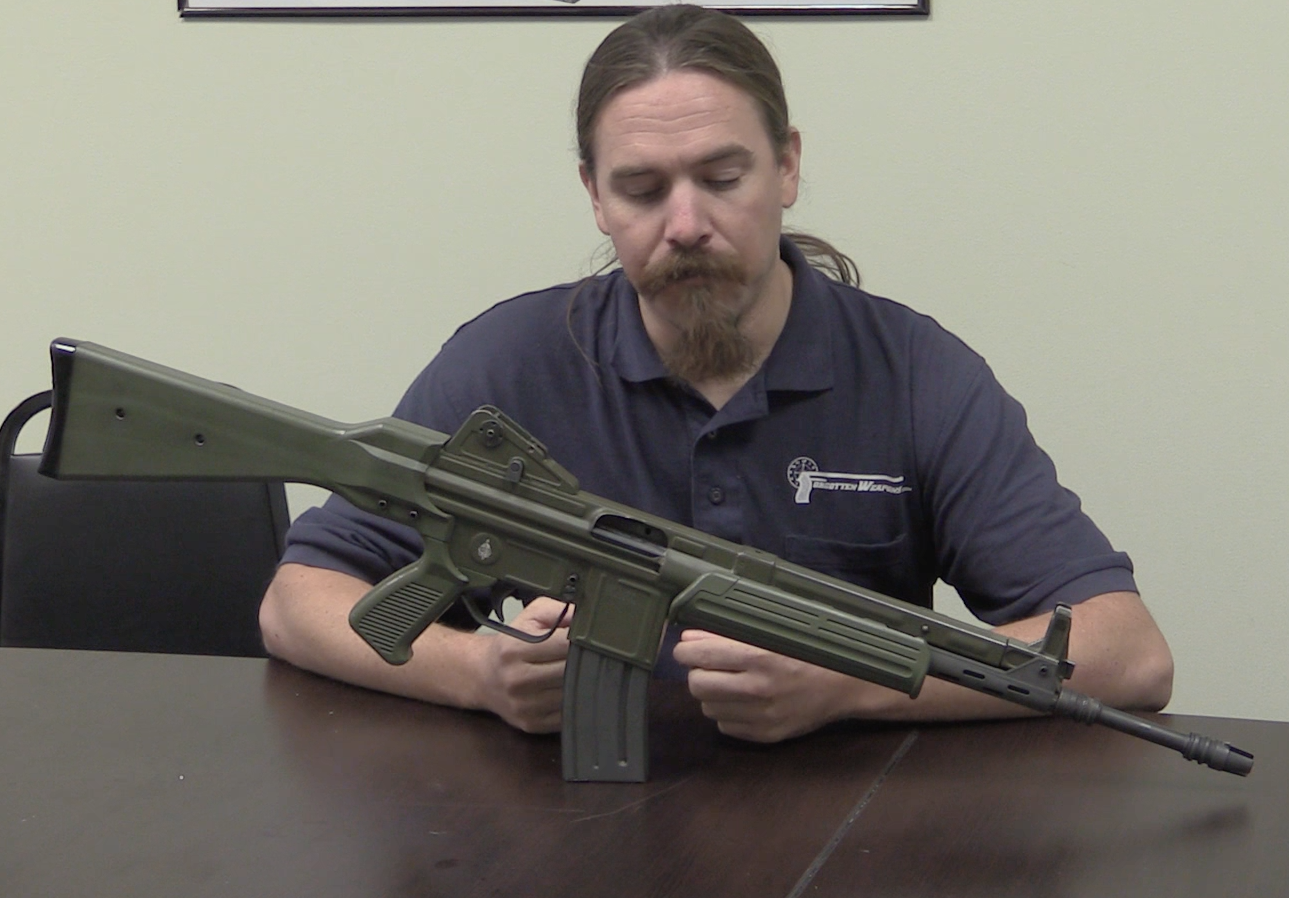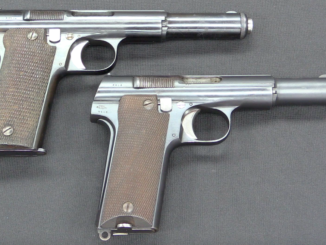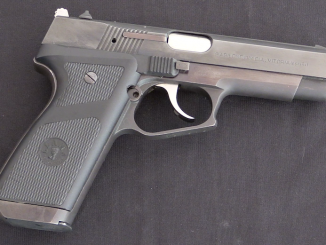The Star Z-70B was an incremental improvement on the earlier Z-62 and Z-63 submachine guns adopted by the Spanish military and security services. It remains an open bolt, selective fire design, with an underfolding stock. The trigger has changed from a progressive type to a standard trigger with a 3-position safety/selector lever (safe, semi, full). In addition, the Z-70B was chambered for 9x19mm instead of the more antiquated 9x23mm Largo cartridge.
While the stock geometry lends itself to the gun climbing in fully automatic, I was pleasantly surprised by how nice it was to shoot. Not the world’s best 9mm SMG, but far from the worst! These are still in service with Spanish armed forces in some roles, and one can certainly understand why.




Bring back memories when I was young, waiting near the franco-spanish frontier to pass to Spain for some vacations with the local family.
Nearly all the Guardia Civil troopers have one of these because of the terrorist alert due to ETA’s action. Very disturbing (and rare) at the time to see european LEOs armed to the teeth.
Now sadly not so rare anymore as even the army is on the streets due to islamic terrorism threat in many countries.
Thanks for the vid, I still mourn the spanish small arms industry watching things like these…those politicians are the worst.
Technically, the Guardia Civil is a “militarised corps”. Of course, they consider themselves military when it suits them (to go to international missions with triple monthly salary) or just “purely” civilian LEO when being military gives them trouble (our disciplinary law, for example).
😉
I think the Rhodesians would rather have had THIS, than the gun shown yesterday.
I always had interest and degree of respect for Star SMG’s. They are cleverly designed with common sense features. I like the stock (far better than that on vz.25/27). Also I noticed the length of receiver behind grip. That may be additional (in absence of knowing size of action) space for action to recoil into. Rate of fire looks modest.
On topic of butt drop and resulting tendency to climb I’d say – you have a choice: either low sights and butt as is or straight(er) stock and high sights. Which would be your choice? I like it the way it is; it’s more compact overall.
“(…)vz.25/27(…)”
What is that?
“Rate of fire looks modest.”
Modern firearms: http://modernfirearms.net/en/submachine-guns/spain-submachine-guns/star-z-62-z-70b-eng/ states 550 rpm
https://www.youtube.com/watch?v=M2OEoGHtc0o
Age shows… 🙂
“”
Ah, you mean this sub-machine gun.
To avoid confusion in future please refer to these weapon as follows:
Samopal vz. 48a – 9×19 sub-machine gun of Czechoslovak origin with wooden (fixed) stock
Samopal vz. 48a/52 – 7,62×25 sub-machine gun of Czechoslovak origin with wooden (fixed) stock
Samopal vz. 48b – 9×19 sub-machine gun of Czechoslovak origin with folding stock
Samopal vz. 48b/52 – 7,62×25 sub-machine gun of Czechoslovak origin with folding stock.
Using name vz. 25/27 for any of this weapon is error, as it would imply it was adopted in 1925 and upgraded in 1927, moreover accepting such name would have catastrophic effects, as it would mean that you can combine P for Pattern with any number used to denote weapon which was NOT its adopting year and thus if you accept such designation for Samopal, then you must accept P27 [understanded as Pattern (19)27] for M27 Infantry Automatic Rifle as correct.
Don’t go around telling people what to call what. Everyone knows that the submachine gun family is referred to as the Vz.2x series. Not all designations denote year of adoption.
“Everyone(…)Vz.2x series”
Ok, then deliver manual or any official document of Czechoslovak forces referencing this weapon this way.
Daweo is bit petty, but he is right. If we call things such as “the one with holes in it and bent end” we would not get very far. Every communication needs some rules.
Since now on I call Daweo “Mr. Accurate”, or Mr.A. for short 🙂
samopal 25 (fixed stock) and sa 26 (folding stock) were both 9mm, and intrepid Ian gave a demonstration of the latter. Both were removed from inventory when the CSSR moved to Warsaw Pact 7.62x25mm, which resulted in the sa 27 and sa 28.
When I’m back at the library, I can tell you what the Czechoslovak documents that ordered their shipment to Cuba say regarding the nomenclature. Sub-ametralladora, or pistola ametralladora (machine pistol, like German) or “la metralleta” a slang term like “mitraillette” in French… Sa26 9mm checoslovaco.
“samopal 25 (fixed stock) and sa 26 (folding stock)”
This designations were also used, though notice that there is not vzor or vz. before number.
“Resolution of the 42nd Meeting of the Czechoslovak Communist Party Regarding Talks with Representatives of the People’s Socialist Party of Cuba, March 24, 1959 and CPCz Politburo Resolution (with enclosures) on Arms Transfers to Cuba, September 1959.” Moving to the enclosures, we find:
“…2. s dodánim 50 000 kusû 9 mm samopalû cs. vzoru 23/25 a pozadovaného mnozstvi prislusné munice ozbrojen´ym silám Kuby prostrednictvim sv´ycarské firmy Phillipp Friedländer. …
2) s. B. Lomskému ve spolupráci se s. F. Krajcirem uvolnit v r. 1959 a 1960 ze zásob vojenské správy k úcelu uvedenému v bodê II/2 celken 50 000 samopalû 9 mm vz. 23/25 a 80 miliónû kusû 9 mm nábojû, a to tak, aby nejménê 15 000 kusû mohlo b´yt vyvezeno pocátkem prosince 1959. …”
Is it the case, therefore, that “vz” and “vzor” and “vzoru” are used interchangeably as “year of/model” and “type?”
Incidentally, these 9mm metralletas checas were very widely used by the MNR during the so-called “lucha contra bandidos” or “limpieza del Escambray” as the consolidation of the revolutionary regime versus opponents and counter-revolutionaries was called, as well as in the Bay of Pigs/ Playa Girón invasion and after.
““Resolution of the 42nd Meeting of the Czechoslovak Communist Party Regarding Talks with Representatives of the People’s Socialist Party of Cuba, March 24, 1959 and CPCz Politburo Resolution (with enclosures) on Arms Transfers to Cuba, September 1959.”
Ah, so this is culprit of that vz. 23/25 name.
For consistency sake, taking in account that all other Czechoslovak-made firearm, which I am aware of, follow vz. xy where xy – last 2 digits of year of adoption convention, using vz. 48 is better.
Honestly, I don’t think that is the “cuprit of that vz. 23/25 name.”
Very few North Americans are aware of such Cold War-era records that have come to light explaining the appearance of various weapons in conflict zones, in this case the Czech VZ52 she self-loading carbines, 9mm sa25 SMGs, and ZB 7.92x57mm MMG/HMGs and 12mm quad-barrelled AA machine guns among others in Cuba in the early 1960s.
What I am asking, not knowing any Slavic languages, is whether “year of” and “model” or “type” or even “style” can be interpreted from the use of vzor “year of” or “vzoru” as in “samopalû 9 mm vz. 23/25” in an official CSSR Communist Party document.
“trigger has changed from a progressive type to a standard trigger with a 3-position safety/selector lever (safe, semi, full)”
What was reason for that change? First one seems more intuitive for me (press a bit if you want single and press fully when you need to fire badly) while second offer more positive separation of firing modes.
Because many soldiers, under stress, are likely to pull the trigger all the way back. The less training and experience, the more likely this is to happen.
The z62 z63 and z70 had a trigger that gave semi auto if just the lower part was pulled
If the top part was pulled back, then pulling back the lower part gave full auto
The effect is somewhat analogous to a grip safety
Only it is on the trigger itself and it’s a fire selector
The sectional drawings in Star’s patents (and in several gun books) show how the mechanism worked
It’s not exactly a progressive trigger.
I’m not sure what the reason for the change to a 3 position safety and selector was.
Whether there were training or discipline reasons
Or whether it was just fashionable
“The z62 z63 and z70 had a trigger that gave semi auto if just the lower part was pulled”
Thanks for explanation, “progressive type” confused me, so in reality it was MG 34-style trigger?
“whether it was just fashionable”
This combined with 9×19 instead of 9×23 Largo, cause me to suspect that they might be looking for export market.
Partly that, but mostly it was Franco wanting Spain to be more closely allied with the rest of the NATO countries. Changing the army’s SMGs from a “Spain-specific” 9mm round to the one everybody else used was one way of helping that along.
As for the trigger group, the original Z-62 did indeed have a trigger that operated exactly like that of the early MG-34. (The later MG-34/1 and -/2 models had a conventional trigger like the successor MG-42, and only fired full-auto.) The changeover was due to both simplification for cheaper mass-production (that “rocker” trigger was both tricky and expensive to fabricate) and also to have the same manual of arms for all infantry small arms as much as possible.
Like the MG-34 in the Wehrmacht, the Z-62 was the only Spanish Army or National Police small arm with that odd trigger, and it required extra training to use it properly. Far better to have a trigger that worked like the CETME rifle, or the Llama self-loading pistol; all a recruit had to remember was “keep your finger off the trigger until your sights are on the target”, followed by breath control and trigger squeeze.
Incidentally, the Z62 had a brief moment of American TV glory when it showed up in a first season episode of Miami Vice– as a stand-in for the Interdynamics KG-9 “Jam-a-Matic” 9mm pistol;
http://www.imfdb.org/wiki/Miami_Vice_-_Season_1#Star_Z62_submachine_gun
I have the episode on DVD, and the Z62s are definitely referred to as KG-9s. It makes perfect sense, as the script required them to actually be fired, with blanks; a real KG-9 had problems with firing, period.
cheers
eon
Actually, the Star Z-45, which was a sort of MP40 copy but with wooden vs. bakelite stock furniture, and which retained 9mm largo, also used this trigger design, whereby the bottom produced self-loading fire, and the top trigger could fire full-auto. Apologies for the pedantry!
The clever stuff that Ian refers to inside the bolt on well worth checking out
The Z-62/70 is based on the British Sterling SMG with the magazine relocated to the bottom and the barrel head changed to a tapered design with the slender end facing the target.
The cutaway view shows something like the safety secondary sear found on Walther MPL.
I recall how unfair was the description of these two guns on Military Small Arms of the 20th. Century.